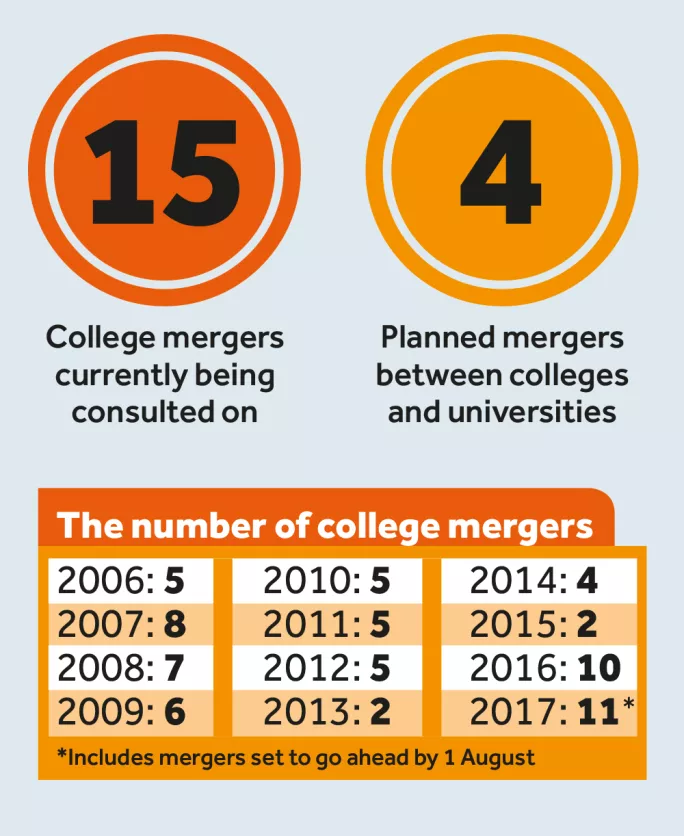The jury’s still out on the legacy of area reviews

At the time of incorporation back in 1993, there were 427 colleges in England. Within a matter of months, it is likely there will be fewer than 300.
The government’s approach towards college mergers in the intervening period has been somewhat changeable. Under the coalition, the number of mergers dropped markedly to just two a year at its lowest (see graphic, below).
But the ongoing period of austerity tipped the balance back in favour of mergers once more in 2015. Nick Boles, who was the skills minister at the time, unveiled plans for a series of reviews of college provision across England. These have become widely known as the area reviews. The goal of the project was to create a FE sector made up of “fewer, larger, more resilient and efficient” colleges.

With the role of FE commissioner having also been created to weed out struggling colleges, the message was clear: colleges had to get their house in order - and quickly. Speaking in March 2016, Mr Boles was at pains to stress the urgency of the situation - and the finite resources available to fund the wholesale restructuring of the sector.
He told college leaders: “You cannot sit out these area reviews and say, ‘Let’s see how the chips fall and continue on roughly as we are, and [we] can always come back later in this Parliament and have another go.’ Once that fund is used up, you are basically on your own.”
The first wave of reviews kicked off in 2015. Those involved speak of somewhat chaotic discussions, particularly in the cases of Manchester and Birmingham. Often, policies with major ramifications for the process - not least the move to allow sixth-form colleges to leave the college sector altogether and become academies - were only announced part-way through it.
Escaping the axe
And then, after weeks of doom-mongering about yet another massive cut to the sector’s finances in the 2015 autumn statement, the sector, remarkably, escaped the axe. This unexpected good news, though, left colleges unsure about how to regard the area reviews.
By the time the final waves of reviews came to an end this spring, the process had become more streamlined. Better systems were in place. But at the same time, the urgency of the process, according to many, appeared to have drained away. Many colleges were left with the impression that, provided their finances and forward plans were solid, they could keep their heads down and carry on with business as usual.
Accordingly, the legacy of the area reviews is hard to gauge. Of course, some colleges decided to take matters into their own hands and pursued merger plans before their area reviews had even begun. Conversely, many recommendations from the reviews will never come to fruition. Since the start of 2016, there have already been 16 college mergers; over the next 12 months, there could well be 30 more. But with predictions from the former FE commissioner, Sir David Collins, having ranged from 50 to 80 mergers, it’s hard not to come to the conclusion that the scale of change has not quite been as big as had been envisaged.

Richard Atkins, who replaced Sir David as FE commissioner last year, has insisted that the reviews have been successful. The acid test, however, has to be: do we now have the financially resilient sector that was promised?
The answer would seem to be no. As Mr Atkins told Tes back in November: “I think you will have colleges that are unable, for various reasons, to implement what they’ve agreed to. They will need support; there will be a few of those. And, sadly, there will be a few colleges that will probably still require [government] intervention.”
As our analysis (see “College groups: will slow and steady win the race?”) reveals, we will undoubtedly end up with fewer, larger institutions. As to whether they will bring the resilience and efficiency promised, the jury is still out.
You need a Tes subscription to read this article
Subscribe now to read this article and get other subscriber-only content:
- Unlimited access to all Tes magazine content
- Exclusive subscriber-only stories
- Award-winning email newsletters
Already a subscriber? Log in
You need a subscription to read this article
Subscribe now to read this article and get other subscriber-only content, including:
- Unlimited access to all Tes magazine content
- Exclusive subscriber-only stories
- Award-winning email newsletters